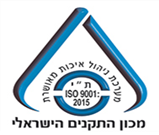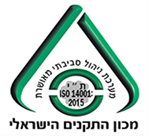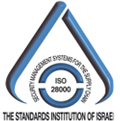Quality and Environment
ISO 27001:2013
|
ISO 9001:2015
|
ISO 14001:2015
|
ISO 28000
|
||||
 |
 |
 |
 |
||||
Silicom Quality and Environmental Declaration:
Silicom upholds the highest quality systems, environmental and safety standards, and complies with the relevant regulations and standards. Our Quality Management system fulfills the requirements of ISO 9001, and our Environmental Management system complies with ISO 14001. In order to meet demands of those standards, the company operates a quality assurance system that accompanies its internal and external activities and operations in all the following activities: research and development, business operations, production and test operations, consultancy to customers, sales and delivery execution, and follow-up to insure customer satisfaction.
Silicom RoHS3 Policy and Declaration
Silicom is dedicated to serving its customers by providing high quality engineered access hardware solutions that meet environmental regulations, including EU Directive 2015/863 and subsequent amendments of the European Parliament and of the Council of the use of certain hazardous substances in electrical and electronic equipment (EEE) and REACH (Registration, Authorization and Restriction of Chemicals, European Union Regulation (EC) 1907/2006).
Accordingly, Silicom has implemented a rigorous program designed to ensure compliance of its products with the RoHS3 Directive. Silicom’s program includes the following measures, among others, as we have deemed appropriate:
- Strictly controlling the materials and finishes that are used in our products, when appropriate performing material content testing,
- Where relevant to Silicom’s products, seeking confirmation from our suppliers as to compliance of their parts and other materials with the RoHS3 Directive,
- Introducing new compliant materials and components to replace non-compliant materials,
- Maintaining inventory and record-keeping systems to confirm, document, identify, and segregate compliant products and materials from non-compliant products and materials.
- Appropriate labeling of products (or packaging),
- Periodic analysis, on an as-needed basis, of our products.
Silicom is providing customers the following information to assist you in meeting your environmental policies and procedures:
RoHS Compliance
Silicom has been producing parts that are RoHS compliant for the last several years. All Silicom products are compliant with the RoHS Directive (EU Directive 2015/863 and subsequent amendments) and marked “RoHS COMPLIANT” or “LEAD-FREE”, which means that the substances restricted by the EU Directive 2015/863 and subsequent amendments of the European Parliament are not contained in a finished product above threshold limits stated below unless the restrictive substance is subject of an exemption contained in the RoHS Directive.
| Restricted Substance | Maximum Threshold Limit |
| Cadmium and its compounds | 100 ppm (0.01 weight %) |
| Mercury and its compounds | 1000 ppm (0.1 weight %) |
| Hexavalent chromium and its compounds | 1000 ppm (0.1 weight %) |
| Lead and its compounds * | 1000 ppm (0.1 weight %) |
| Polybrominated biphenyls (PBB) | 1000 ppm (0.1 weight %) |
| Polybrominated diphenyl ethers (PBDE) | 1000 ppm (0.1 weight %) |
| Decabromine diphenyl ether (DECA BDE) | 1000 ppm (0.1 weight %) |
Directive (EU) 2015/863 was published in 2015 by the EU commission, which is known as RoHS 3. RoHS 3 adds four additional restricted substances (phthalates).
Silicom fully supports the restriction of the four substances :
- Bis(2-Ethylhexyl) phthalate (DEHP): max 0.1%;
- Benzyl butyl phthalate (BBP): max 0.1%;
- Dibutyl phthalate (DBP): max 0.1%;
- Diisobutyl phthalate (DIBP): max 0.1%.
Silicom is updating its standards according to the changes in the requirements of the standards from time to time.
Silicom PCBs / PCTs Policy and Declaration
Polychlorinated Biphenyls (PCBs) are among a group of man-made chemicals that are known as Persistent Organic Pollutants (POPs). PCBs were commercially produced world-wide on a large scale between the 1930s and 1980s. Given their extraordinary chemical stability and heat resistance, they were extensively employed as components in electrical and hydraulic equipment and lubricants.
They have been used in two types of applications:
1. Closed uses: dielectric fluids in electrical equipment such as transformers, capacitors (big industrial capacitors, but also small capacitors in household electrical appliances), heat transfer and hydraulic systems.
2. Open uses: as pesticide extenders, sealant, carbonless copy paper, industrial oils, paints, adhesives, plastics, flame retardants and to control dust on roads.
In the 1970s, owing to severe concerns pertaining to their human toxicity, suspected carcinogenicity, and environmental persistence, several countries limited the use of PCBs. Finally in 1985, the use and marketing of PCBs in the European Community were very heavily restricted.
PCBs are classified as probable human carcinogens and produce a wide spectrum of adverse effects in animals and humans, including reproductive toxicity, teratogenicity and immunotoxicity.
They can be transported long distances and have been detected in the furthest corners of the globe, including places far from where they were manufactured or used. They have been detected in virtually all environmental media (indoor and outdoor, surface and ground water, soil and food).
Directive 96/59/EC on the disposal of PCBs and PCTs aims at disposing completely of PCBs and equipment containing PCBs as soon as possible. This Directive sets the requirements for an environmentally sound disposal of PCBs. Member States have to make an inventory of big equipment containing PCBs, have to adopt a plan for disposal of inventoried equipment, and outlines for collection and disposal of non-inventoried equipment (small electrical equipment very often present in household appliances manufactured before the ban on marketing of PCBs). Furthermore, the Commission has adopted a Community Strategy on Dioxins, Furans and PCBs aimed at reducing as far as possible the release of these substances in the environment and their introduction in the food chains.
To the best of Silicom’s (including its subsidiaries) knowledge and belief, Silicom products do not contain PCB / PCT.
Silicom is unaware of any potential sources for the introduction of PCB / PCT from the manufacturing and packaging processes utilized, nor from the packaging components themselves. However, Silicom does not specifically analyze for the presence of PCB / PCT. This information is provided in good faith and is believed accurate based on a review of current composition and information supplied by vendors.
Silicom REACH Substances of Very High Concern (SVHC)
Policy and Declaration
REACH is the European Community Regulation on chemicals and their safe use (EC 1907/2006). It deals with the Registration, Evaluation, Authorization, and Restriction of Chemical substances. The law entered into force on 1 June 2007.
The aim of REACH is to improve the protection of human health and the environment through the better and earlier identification of the intrinsic properties of chemical substances. At the same time, REACH aims to enhance the innovation and competitiveness of the EU chemicals industry. The benefits of the REACH system will come gradually, as more and more substances are phased into REACH.
The REACH Regulation places greater responsibility on the industry to manage the risks from chemicals and to provide safety information on the substances. Manufacturers and importers are required to gather information on the properties of their chemical substances, which will allow their safe handling, and to register the information in a central database run by the European Chemicals Agency (ECHA) in Helsinki. The Agency acts as the central point in the REACH system: it manages the databases necessary to operate the system, coordinates the in-depth evaluation of suspicious chemicals, and is building up a public database in which consumers and professionals can find hazard information.
The Regulation also calls for the progressive substitution of the most dangerous chemicals when suitable alternatives have been identified. For more information to read REACH in Brief visit: http://ec.europa.eu/growth/sectors/chemicals/reach/
One of the main reasons for developing and adopting the REACH Regulation was that many substances have been manufactured and placed on the market in Europe for many years, sometimes in very high amounts, and yet there is insufficient information on the hazards that they pose to human health and the environment. There is a need to fill these information gaps to ensure that the industry can assess the hazards and risks of the substances and identify and implement risk management measures to protect humans and the environment.
The regulation has an important impact on the availability of substances and preparations (chemicals) on the market. Substances in volumes of one ton and more per year must be neither manufactured in nor imported into the EU nor put on the market after 1 June 2008 unless they are registered following the principle “no data, no market”. Registration concerns substances on their own, in preparations, and in articles, if they are intended to be released from the article.
In our continuous efforts to provide you with information about REACH, we wish to inform you that a list of chemicals being considered as candidates for SVHC classification under REACH regulations has been posted by the European Chemicals Agency (ECHA) and an updated list of substances may be found in the link:
https://echa.europa.eu/candidate-list-table
As a leading developer and manufacturer of network adaptors, Silicom takes seriously our responsibility to comply with environmental, health, and safety regulations in all the markets in which we operate.
Silicom is fully aware of the European REACH regulation and is committed to achieving compliance within the required timeframe, in cooperation with our suppliers and customers.
Silicom products do contain substances that are on the candidate list of substances of very high concern above the reporting threshold of 0.1%, and therefore Silicom will provide a full concentration report to its customers to help with the SCIP report needed in this case.
Silicom is constantly monitoring the substances of very high concern (SVHC), as defined by REACH, in our products. This will be an ongoing process since the complete list of SVHCs will be released in stages.
As a Responsible Customer, Silicom
- Creates awareness of supplier’s obligations under the Regulation,
- Requires from all its suppliers to comply with REACH Regulation,
- Encourages suppliers to implicate this requirement through entire supply chain to next tiers suppliers.
Silicom PFOS and PFOA Policy
Silicom products do not contain as intentionally additives perfluorooctane sulfonates (PFOS) as identified in European Union Directive 2006/122/EC, Amendment 30.
The content knowledge of materials used in the manufacturing process and in the finished packaged product is based on information provided from third parties.
In addition to PFOS, Silicom does not intentionally add perfluorooctanoic acid (PFOA) to our products.
Silicom takes commercially reasonable steps to provide accurate information, but has not independently conducted destructive testing methods or chemical analysis for PFOS and PFOA.
Silicom Ozone Depleting Substances Policy
Silicom deliverable products do not contain ozone depleting substances that are subject to the Montreal Protocol on Substances that Deplete the Ozone Layer and U.S. Clean Air Act, Title VI Regulations.
The Montreal Protocol is an international treaty designed to protect the ozone layer by phasing out the products of a number of substances believed to be responsible for the ozone depletion.
Ozone Depleting Substances include CFCs, Halons, HCFCs, Carbon Tetrachloride, Hydrochlorofluorocarbons, Hydrobromofluorocarbons, Trichloroethane (Methyl chloroform), Methyl bromide, Bromochloromethane.
The ODS list is dynamic and should not be assumed to be the final substance candidate list.
Silicom Environmental, Health, and Safety Policy
Silicom will promote, create, and maintain a safe and healthy workplace and is committed to improving the environmental quality of our operations and surrounding communities. This effort begins with providing a safe physical plant and a working environment that promotes hazard-free working conditions. We all share the responsibility for maintaining a safe workplace. Our commitment to the safety of our employees is based on the following principles:
- All injuries can be prevented
- Management is responsible for preventing injuries
- Employee involvement is essential
- Training employees to work safely is essential
- Working safely is a condition of employment
- All employees are responsible for their safety and the safety of those around them
Silicom will continuously improve all activities with focus on pollution prevention, waste minimization, reduction in use of chemical raw materials & natural resources. Silicom will work to improve its products and processes to reduce its environmental, safety & health impact by:
Minimizing any significant adverse environmental impacts or safety/health risks to employees, customers and the public, through the use of integrated EHS management procedures and planning
- Maintaining compliance with all applicable international, federal, state and local regulations and laws,
- Preventing pollution, reduce waste emissions, and commit to reduction, reuse, recovery and recycling,
- Securing and maintaining all applicable permits and other regulatory approvals required for operations,
- Continually assessing and anticipating future EHS laws and regulations and the effects they may have on our operations for control and planning.
Silicom is proud of its environmental record and its commitment to protect the environment.
Silicom is ISO14001 certified and has a well established Safety and Environmental team that strives to exceed regulatory and safety standards.
CALIFORNIA PROPOSITION 65 PRODUCT COMPLIANCE
Under the California Safe Drinking Water and Toxic Enforcement Act of 1986 (known as Proposition 65 or “Prop 65”), the State of California creates and updates annually a list of chemicals known by the State of California to cause cancer or reproductive toxicity (“Prop 65 List”).
Prop 65 requires “clear and reasonable” warnings to be given if, in the course of doing business, a person knowingly and intentionally exposes an individual in California to a chemical on the Prop 65 List. Prop 65 also prohibits knowingly discharging or releasing a chemical on the Prop 65 List such that it is likely to, or will, enter any California drinking water source.
Based upon Silicom’s current level of knowledge of our internal business operations and chemicals used and according to our supplier’s declarations, Silicom’s products do not require a Proposition 65 warning label.
Silicom does not control or have knowledge of the end uses or specific applications of our products by our customers.
The decision to include or not include a Proposition 65 notice (label) must ultimately rest with the customer utilizing Silicom’s products
*** We recommend our customers to use the following warning to California customers
 |
WARNING: Cancer and Reproductive Harm – www.P65Warnings.ca.gov |
Additional information concerning Proposition 65 can be found at the following web site:
https://oehha.ca.gov/proposition-65/proposition-65-list
https://oehha.ca.gov/proposition-65
Halogen Free Compliance Status
Halogens are highly reactive, and they can be harmful, as they can form toxic and corrosive gases. Hence, in many applications, in various industries like electronics, aerospace, and optical, there arises a need for using halogen-free adhesives. Due to the concern of health and environmental issues caused by halogens, the International Electrochemical Commission (IEC) set forth a standard called IEC 61249-2-21, which defines halogen-free as the following:
• Chlorine ≤ 900 ppm
• Bromine ≤ 900 ppm
• Total Halogens ≤ 1500 ppm
We at Silicom collect from all our suppliers Halogen data and request for updates whenever is needed.
At the moment and based on our suppliers’ declarations some of Silicom products are not a Halogen Free. We are working with our suppliers to improve this status and become a Halogen Free company in the future.
For further information regarding specific Silicom product please contact Silicom compliance group: [email protected]
Silicom updated RoHS3 and REACH statement can be found at:
REACH Statement (Silicom company SVHC Declaration
RoHS& California 65 Statement (RoHS 3, China RoHS & Taiwan RoHS & California 65 -All products)


